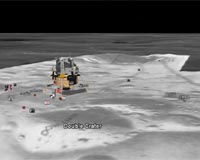 |
Tucson AZ (SPX) Jul 23, 2009 The 40th anniversary of the Apollo lunar landing is a time to look back and, especially, an opportunity to look forward to future space exploration, including the Moon missions now being planned by NASA and other space agencies, said Mark A. Bishop, an associate research scientist with the Tucson-based Planetary Science Institute. Bishop talked with commentators Matthew Abraham and David Bevan about the primitive equipment used to send the first men to the Moon and why studying the Moon and other bodies in our solar system is important to understanding climate change on Earth and to plans for establishing colonies in space. He also answered listeners' questions during the 25-minute program. "There's a huge amount of information on other planets that relates to climate change on Earth," said Bishop, who also is with the University of South Australia's School of Natural and Built Environments. These planets and moons are like a history book that we can study to determine how climate change has affected bodies elsewhere in our solar system and, therefore, to better understand where Earth's climate may be headed, he said. While the Apollo moon missions were guided by computers that had no more processing power than some of today's digital watches, the huge computing capabilities of NASA's Lunar Reconnaissance Orbiter, which is now circling the moon, are allowing it to map the entire lunar surface down to a resolution of half a meter, he noted. Other missions have shown that water ice may exist in the depths of some lunar craters or near the Moon's poles, Bishop added. Mining companies may eventually exploit this water and the vast amounts of other lunar natural resources for use on the Moon and Earth, Bishop said. The water can be used to produce oxygen for astronauts living at lunar bases and for rocket fuel for return trips to Earth. Besides its valuable, practical results, space exploration also provides inspiration, he said. "Humankind needs inspiration. The kids need something exciting to look forward to." In a world often filled with negative news, seeing a robotic rover rolling across the surface of another planet or a human footprint in the lunar dust is uplifting to the human spirit, he added. "Within the next ten years, we're going to return astronaut teams to the Moon," Bishop said. "But in the meantime, there's going to be a huge amount of observation." This will include data gathered by spacecraft such as the Lunar Reconnaissance Orbiter and rovers on the surface. Forty years after the first Apollo astronauts set foot on the Moon, we are now entering a renaissance in lunar exploration that promises to be every bit as inspiring and exciting and even more scientifically valuable, he said. Share This Article With Planet Earth
Related Links Planetary Science Institute Mars News and Information at MarsDaily.com Lunar Dreams and more
 Google adds Moon to online Earth map service
Google adds Moon to online Earth map serviceSan Francisco (AFP) July 20, 2009 Google on Monday marked the 40th anniversary of the first human footsteps on the moon by adding virtual lunar exploration to its free online Earth map and imagery service. The moon joins Earth, Mars, and Sky in an options list in an upper tool bar on the main Web page at earth.google.com. Aspiring lunar explorers will need Google Earth 5.0 software, which can be downloaded free. ... read more |
|
| The content herein, unless otherwise known to be public domain, are Copyright 1995-2009 - SpaceDaily. AFP and UPI Wire Stories are copyright Agence France-Presse and United Press International. ESA Portal Reports are copyright European Space Agency. All NASA sourced material is public domain. Additional copyrights may apply in whole or part to other bona fide parties. Advertising does not imply endorsement,agreement or approval of any opinions, statements or information provided by SpaceDaily on any Web page published or hosted by SpaceDaily. Privacy Statement |